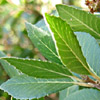Phillyrea latifolia (Broad-Leaved Phillyrea) is a small evergreen tree. The leaves resemble those of the Palestine Oak (Quercus calliprinos), but two traits may help differentiate between them: the dentation on the margin of the oak leaf is irregular, and differs from one leaf to the other even on the same tree, whereas in the Broad-Leaved Phillyrea, the dentation is regular, and completely uniform in all the leaves. In the Broad-Leaved Phillyrea the leaves are opposite, i.e. arranged on the branch in pairs opposite each other. In the oak they are alternate. When the tree carries fruit it is naturally easy to differentiate between them, because the oak fruit is an acorn inside a cupule, whereas the Broad-Leaved Phillyrea has a fruit that resembles little olives.
Phillyrea latifolia blooms in the spring. The flower is tiny, with 4 sepals, 4 greenish-white petals and 2 stamens. The flowers are numerous and grow together in clusters that are reminiscent of the inflorescence of the olive. The fruit ripens in October. It has a spherical shape, like a small olive, but less elongated. It is green at first, then red, and when it ripens it is blue-black.
Broad-Leaved Phillyrea grows in the Israeli Maqui, in all parts of the country from the Judean Mountains and northward, mainly in the Galilee from west of the watershed. Its Arabic name barza has been intertwined with the fact that it is related to the olive, which is how it was awarded its Hebrew name. The species is the only one of its genus in Israel. Its global distribution spreads over the countries surrounding the Mediterranean Sea. The genus contains 3 other species, which grow in the Mediterranean and Middle East countries.
Written by Mike Livne





